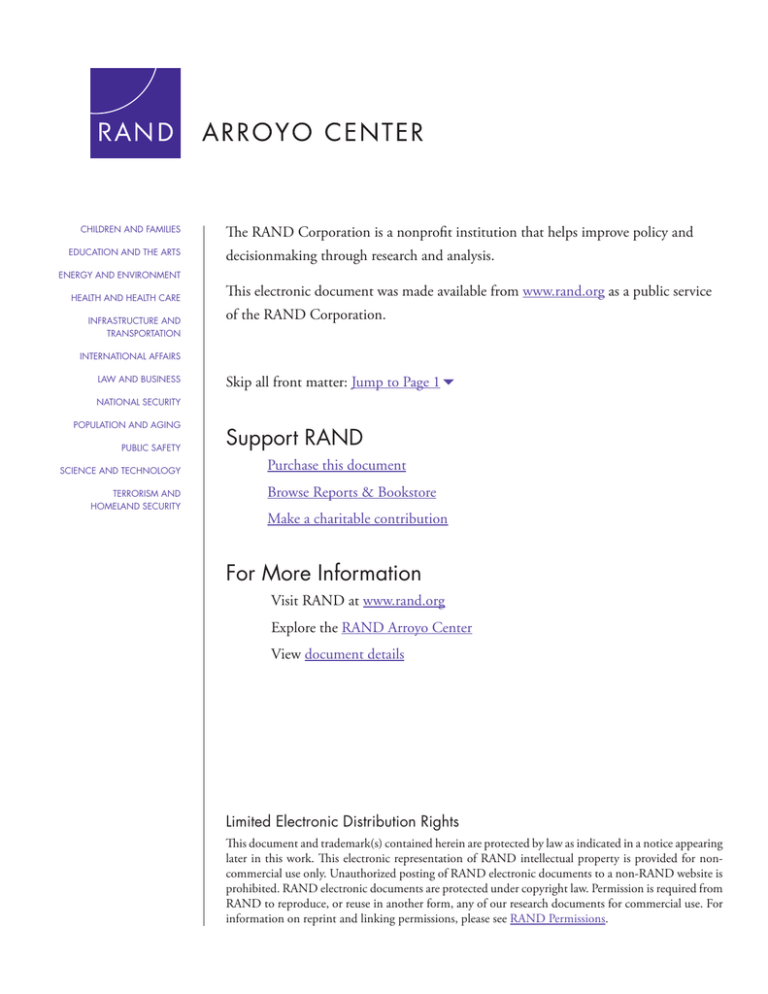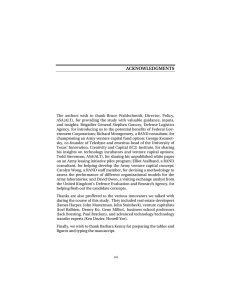The RAND Corporation is a nonprofit institution that helps improve... decisionmaking through research and analysis.
advertisement

CHILDREN AND FAMILIES EDUCATION AND THE ARTS The RAND Corporation is a nonprofit institution that helps improve policy and decisionmaking through research and analysis. ENERGY AND ENVIRONMENT HEALTH AND HEALTH CARE INFRASTRUCTURE AND TRANSPORTATION This electronic document was made available from www.rand.org as a public service of the RAND Corporation. INTERNATIONAL AFFAIRS LAW AND BUSINESS Skip all front matter: Jump to Page 16 NATIONAL SECURITY POPULATION AND AGING PUBLIC SAFETY SCIENCE AND TECHNOLOGY TERRORISM AND HOMELAND SECURITY Support RAND Purchase this document Browse Reports & Bookstore Make a charitable contribution For More Information Visit RAND at www.rand.org Explore the RAND Arroyo Center View document details Limited Electronic Distribution Rights This document and trademark(s) contained herein are protected by law as indicated in a notice appearing later in this work. This electronic representation of RAND intellectual property is provided for noncommercial use only. Unauthorized posting of RAND electronic documents to a non-RAND website is prohibited. RAND electronic documents are protected under copyright law. Permission is required from RAND to reproduce, or reuse in another form, any of our research documents for commercial use. For information on reprint and linking permissions, please see RAND Permissions. This product is part of the RAND Corporation documented briefing series. RAND documented briefings are based on research briefed to a client, sponsor, or targeted audience and provide additional information on a specific topic. Although documented briefings have been peer reviewed, they are not expected to be comprehensive and may present preliminary findings. Strategic Distribution Platform Support of CONUS Army Units Marc Robbins Prepared for the United States Army Approved for public release; distribution unlimited A RROYO CENTER The research described in this report was sponsored by the United States Army under Contract No. W74V8H-06-C-0001. Library of Congress Cataloging-in-Publication Data Robbins, Marc L., 1954Strategic distribution platform support of CONUS Army units / Marc Robbins. p. cm. Includes bibliographical references. ISBN 978-0-8330-5928-4 (pbk. : alk. paper) 1. United States. Army—Transportation. 2. Military trucks—United States. 3. Logistics—United States. 4. Physical distribution of goods—Management. I. Title. UC273.R63 2011 355.80973—dc23 2011045964 The R AND Corporation is a nonprofit institution that helps improve policy and decisionmaking through research and analysis. RAND’s publications do not necessarily reflect the opinions of its research clients and sponsors. R® is a registered trademark. © Copyright 2011 RAND Corporation Permission is given to duplicate this document for personal use only, as long as it is unaltered and complete. Copies may not be duplicated for commercial purposes. Unauthorized posting of RAND documents to a non-RAND website is prohibited. RAND documents are protected under copyright law. For information on reprint and linking permissions, please visit the RAND permissions page (http://www.rand.org/publications/ permissions.html). Published 2011 by the RAND Corporation 1776 Main Street, P.O. Box 2138, Santa Monica, CA 90407-2138 1200 South Hayes Street, Arlington, VA 22202-5050 4570 Fifth Avenue, Suite 600, Pittsburgh, PA 15213-2665 RAND URL: http://www.rand.org To order RAND documents or to obtain additional information, contact Distribution Services: Telephone: (310) 451-7002; Fax: (310) 451-6915; Email: order@rand.org - xi - Summary Home station units depend upon a reliable distribution system to provide the supplies they need to train and prepare for possible deployments. Most of the focus of concern in the past decade has been on how forces deployed to theaters of combat operation have been supported by the global distribution system—understandably, for an Army engaged in two wars. But with forces returning home from Iraq, and with a drawdown anticipated to begin in Afghanistan after July 2011, along with the repositioning of forces in Europe and Korea to the continental United States (CONUS) as part of the Integrated Global Presence and Basing Strategy (IGPBS), support to Army forces in CONUS will be of increasing concern. In addition, as contingencies wind down, budgetary concerns are likely to be of increasing importance. The Department of Defense (DoD), and the Army, will be under increasing pressure to do more with less and will require a distribution system that helps maintain readiness and supports training goals with timely delivery of needed supplies, and does so at the lowest cost possible. This documented briefing presents results of analysis done as part of an ongoing effort by RAND Arroyo Center to support the Army by identifying opportunities for improvements in the DoD distribution system. Arroyo has been working with the Army and its partners in the DoD global distribution system—including the Defense Logistics Agency (DLA), United States Transportation Command (USTC), and General Services Administration (GSA)—for more than fifteen years in some areas of distribution. The cornerstone of support to forces in CONUS is the leveraging of Strategic Distribution Platform (SDP) storage via scheduled truck networks. SDPs are the central element of the DLA distribution concept, responsible for most storage of DoD-owned materiel at the wholesale level and replenishment of other DLA distribution depots, including Forward Distribution Points (FDPs) collocated with service repair depots, and Forward Distribution Depots - xii - (FDDs) located OCONUS to support deployed forces, especially for heavy, bulky items or where the FDD has a distinct performance advantage. DLA’s distribution depot network currently features two SDPs at opposite sides of the country, at Susquehanna, Pennsylvania (DDSP) and San Joaquin, California (DDJC). The primary means of support to large-volume CONUS locations from these two SDPs is via scheduled truck. The scheduled truck network linked to the two SDPs was developed by the Army and DLA (with analytical support from RAND Arroyo Center) under the Army’s Velocity Management initiative in the mid-1990s. This concept has four key elements: • Maximum support from a customer’s assigned SDP. Customers are assigned to SDPs on a roughly geographical basis, with the Mississippi River as the rough dividing line (though central CONUS customers are sometimes switched between SDPs). DLA and the Army have agreed to the goal that the SDP will be the source for 85 percent of customer demands stocked in DLA depots. • Leverage high fill rates via scheduled truck. Where volume and distance permit, customers will be supported from their assigned SDP via scheduled truck service, with the economically feasible maximum number of trucks per week. Higher fill rates from the SDP, achieved through better stockage strategies, increase the volume available to go by truck, lowering transportation costs and enabling greater truck frequency. • Move all priorities via the truck. The new distribution paradigm replaced the previous model based on optimizing individual shipments (e.g., high priority to go by premium air, low priority by slower, cheaper modes). Truck efficiency and effectiveness resulted from lumping all cargo together, no matter its priority or size. Via a “one freight/all freight” concept, all cargo—no matter its size or priority— could achieve premium air-like responsiveness at a fraction of the cost. • Synchronize movements through multiple stops. Scheduled truck service provides better synchronization and feedback mechanisms. By - xiii - building routes for multiple dropoffs, individual units on a post can be served directly by the truck; if schedules are done properly, the truck will arrive at a scheduled time, helping supply units plan operations better. Because the truck is on a schedule, units will be aware when the truck is delayed or does not come at all, and can communicate back to the SDP about problems with the trucking company. Increasing the proportion of demand filled from a customer’s assigned SDP (the “facing fill” rate) facilitates expansion of scheduled truck usage, as Figure S.1 indicates. It also shows, however, a weakening of that tie in recent years, as the percentage of DDSP/DDJC shipments going via scheduled truck flattened after 2003 even as the facing fill at both SDPs increased. That is, the distribution network was not leveraging improvements in facing fill to reduce cost and improve responsiveness to the maximum extent. Figure S.1 Scheduled Trucks as the Dominant Mode for CONUS Army Customers - xiv - Figure S.2 summarizes the present scale of scheduled truck coverage for major CONUS Army posts. Scheduled trucks dominate the volume moved by weight, accounting for 75 percent of pounds shipped from the two SDPs to these twenty major locations. However, many shipments are not moved via the scheduled truck. One result is an imbalance of costs: nonscheduled truck shipments account for 55 percent of transportation costs from the SDPs to these posts, even as they only account for 25 percent of shipment weight. Figure S.2 Cost and Volume Breakout by Mode Use of modes other than scheduled truck can occur for any of three reasons: • “Facing fill” shortfalls: the demanded item is not issued from the customer’s supporting SDP. - xv - • “Leakage”: the supporting SDP issues the item but it does not go on the truck servicing the Army post. • No truck service: there is no scheduled truck service from the SDP to the Army post. One consequence of shortfalls in scheduled truck coverage, along with other issues in scheduled truck performance, is less responsiveness to customer needs, especially compared to alternatives like premium air services. Figure S.3 shows, for major Army posts, the difference between average response time (here measured from the time the materiel release order is produced until the shipment arrives at its destination) between premium air and scheduled trucks. Negative numbers indicate that trucks are more responsive, positive numbers that premium air is faster. In some cases, primarily those closest to the SDP, scheduled trucks outperform premium air, but in the majority of the cases they do not, in some cases by a considerable amount. Strengthening the scheduled truck network will help both reduce costs and increase responsiveness. There are several steps that should be taken by the Army alone and in collaboration with its supply chain partners. The Army currently has no policy guiding the use of this network. HQDA G-4 should provide such a policy. Since “leakage” from units not participating on an existing truck supporting their home station can increase overall costs and reduce effectiveness for their neighbors, the policy should call for all units on a post with scheduled truck service to receive their shipments via the truck unless an explicit waiver has been granted. The policy should also call for better monitoring by the Army. The Army should designate a capable agency to develop metrics and produce recurrent reports on the health of the scheduled truck network. This would include facing fill metrics (based on the standard agreed to jointly by the Army and DLA), identification of posts and major locations not on the truck, and the amount of leakage on Army posts from units not participating in the truck network. - xvi Figure S.3 Comparative Responsiveness of Truck and Premium Air Modes by Army Post The Army should work closely with DLA and, as necessary, with process managers associated with USTC’s Defense Transportation Coordination Initiative (DTCI) to make necessary changes in the truck network. Strengthening the scheduled truck network falls into both near-term and more ambitious long-term actions. Near-term actions: • Add new destinations to existing truck routes. Locations currently not served by trucks but which are located on or near currently existing routes may be added to increase the volume on the route and so reduce cost and/or increase the frequency. - xvii - • Add customers not on the truck at posts served by scheduled trucks. The Army needs to work with DLA and USTC to determine the reasons that units are not included on trucks and the process by which their participation is determined. • Scrutinize reasons for using other shipping modes for customers mainly supported by scheduled trucks. While for most units served by trucks, this is not a significant problem, the Army should still work with DLA to determine the reasons for this type of “low level” leakage and to minimize its occurrence. • Improve SDP processing times. Getting pulled shipments on the next departing truck should be a focus of DLA process improvement efforts, especially for high-priority requisitions. These steps would likely have a moderate effect on scheduled truck comprehensiveness and performance. More significant improvements could be achieved by some more far-reaching changes. One might yield much greater volume on individual routes, lowering costs and improving responsiveness, while another could greatly shorten truck route distance, with the same effect. Longer-term actions: • Cross-dock non-SDP shipments onto scheduled trucks. In addition to SDP shipments, units receive deliveries via multiple shipping modes from GSA and direct from vendor, as well as other sources. Where feasible, it may be worthwhile to explore the possibility of routing shipments from these sources through the SDP and onto scheduled trucks. Not only could this reduce overall cost from the system point of view, but it would simplify processes for customers who, in the best case, would receive all their orders in a single delivery. • Build capability of new regional SDPs to support local customers via scheduled trucks. BRAC recommendation-based laws established two new SDPs in central CONUS (Oklahoma City, Oklahoma) and the southeast (Warner-Robins, Georgia). The two are - xviii - slated to play less comprehensive roles than DDSP and DDJC, primarily focusing on resupplying Forward Distribution Depots in their regions collocated with service repair depots. If in the future resources were made available to facilitize these two as fully capable SDPs, with a target of 85 percent facing fill for their assigned regional customers, support to customers in their regions could be greatly improved. This would especially benefit central CONUS locations that, as shown in the main text, tend to have less frequent trucks with longer delivery times.





